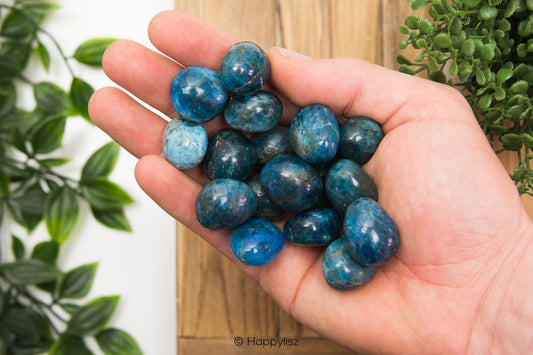Blue Apatite

Self-expression • Growth & Development • Openness • Extraverted • Motivating & Energizing • Creativity
Appearance
Dark blue to light blue in color. A transparent, sometimes fluorescent stone with a glassy to semi-resinous luster.
Rarity
Relatively common.
Self-expression • Growth & Development • Openness • Extraverted • Motivating & Energizing • Creativity
Energetic properties
Blue apatite stimulates self-expression and supports mental, spiritual, and physical growth and development. The stone encourages openness, extroversion, sociability, and liveliness. It also works as a motivating and energizing force. Apatite increases the desire for adventure and variety and enhances creativity. It has a positive effect on spiritual abilities and meditation. Blue apatite also calms and balances the mind. It reduces aggression and negative emotions and helps strengthen concentration. Physically, apatite is revitalizing and stimulates cell growth, cartilage, bones, teeth, and calcium absorption. It is known to positively affect arthritis, osteoarthritis, joint problems, and bone fractures.
Suitable for children from about 10 years old.
Formation
Blue apatite typically forms as a result of hydrothermal processes, where mineral-rich hot water flows through cracks and fissures in rock. This water contains dissolved calcium and phosphate ions that precipitate and crystallize within these openings. This process can occur in a variety of rocks, including igneous, metamorphic, and sedimentary types.
Some blue apatite also forms through pegmatitic processes, where molten magma cools slowly and crystallizes in fissures and gaps in the surrounding rock. This can result in the formation of large crystals.
The final color of blue apatite depends on its specific chemical composition and the conditions during formation, such as pressure, temperature, and the presence of other minerals. Apatite is a phosphate mineral, commonly found, and it appears in a wide range of colors—gray, white, yellow, green, blue, violet, or pink—due to variations in composition.
The general chemical formula of chlorine- and fluorine-bearing calcium phosphate is Ca₅(PO₄)₃(F,Cl,OH). Apatite often contains a combination of fluorine, chlorine, and hydroxyl. Because the differences between these three varieties are often difficult to distinguish, they are commonly grouped together under the name apatite. However, some specimens are composed entirely of just one of these components.
Etymology
Blue apatite is named after the Greek word apatē, meaning 'deceit' or 'to deceive', because it is often mistaken for other gemstones such as beryl, topaz, and aquamarine. The term 'apatite' was first introduced by German mineralogist Abraham Gottlob Werner in 1786 to describe a group of calcium phosphate minerals. The name 'blue apatite' refers specifically to the intensely blue-colored variety.
Care
Apatite should not come into contact with water too often. It is a soft stone, sensitive to scratches, wear, and corrosion—especially when exposed to acidic or alkaline solutions. It is best to clean apatite gently with a dry cloth and avoid soaking it in water or chemicals.
It can also be energetically cleansed and recharged using sage, incense or moonlight.
Origin
Brazil, Canada, Germany, Madagascar, Morocco, Mexico, Portugal, Russia, United States, India, Sri Lanka, Pakistan & Kenya.
Availability
Blue apatite is relatively common and can be found in various locations worldwide. While not considered rare, high-quality specimens with intense blue color and good transparency can be less common and fetch higher prices.
Properties
Composition: Ca₅(PO₄)₃(F,Cl,OH)
Hardness: 5
Density: 3.2
Associated with Blue Apatite







-
Blue Apatite - Tumbled Stone
Regular price €3,50Regular priceUnit price / per -
Orgonite Pyramid - Pisces - No. 1
Regular price €39,00Regular priceUnit price / per€60,00Sale price €39,00Sale! -

 Sold out
Sold out






